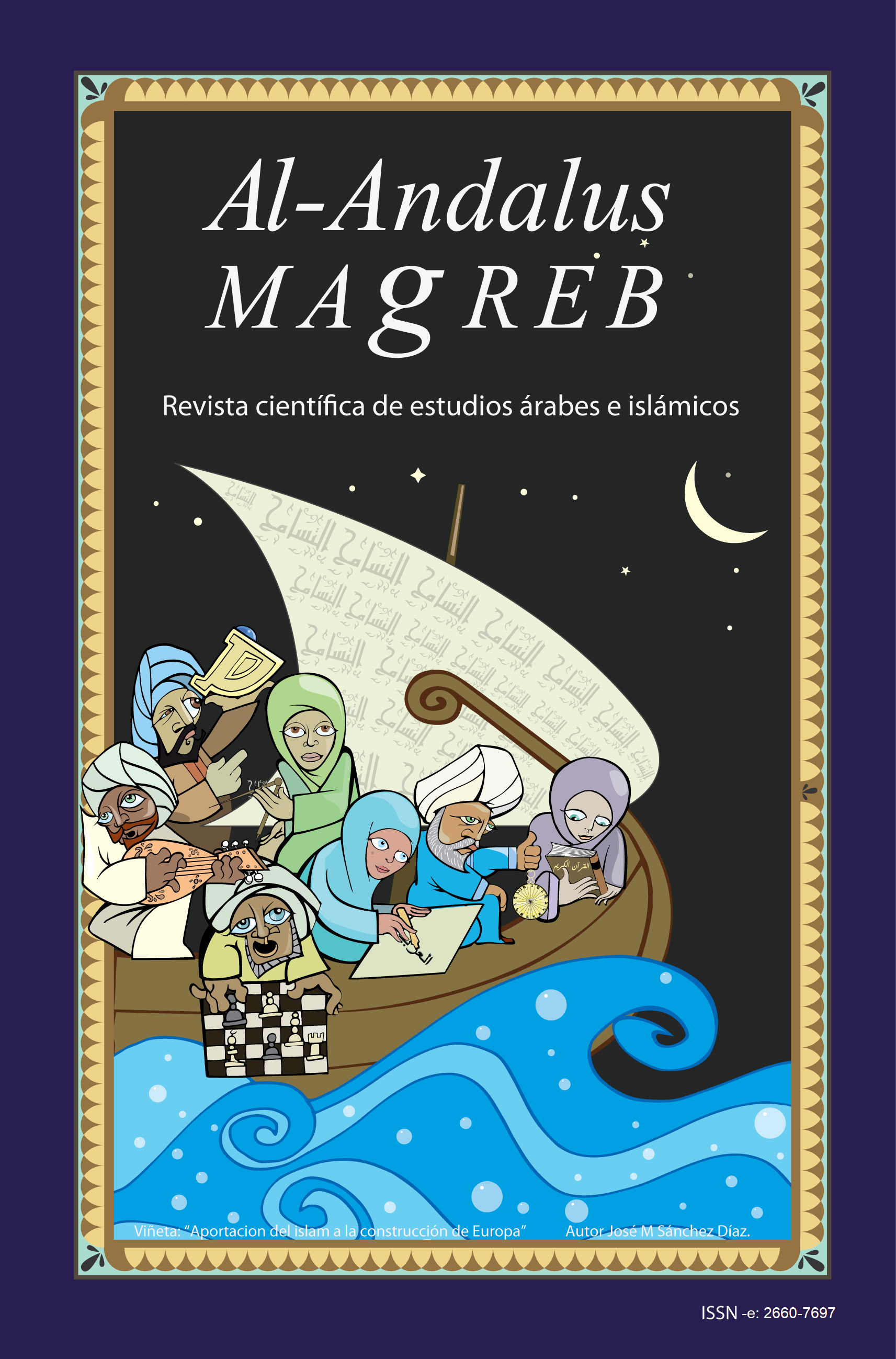The nasīb in popular poetry ḥassānī, lə-ġnä

Downloads
- PDF (Español (España)) 477
- EPUB (Español (España)) 109
- VISOR (Español (España))
- MOVIL (Español (España))
- XML (Español (España)) 97
DOI
https://doi.org/10.25267/AAM.2020.v27.01Info
Abstract
Ḥassānī popular poetry, lə-ġnä, deals with the same themes Classical Arabic poetry does, however, there are differences between the two regarding the use of some themes, especially in nasīb. This article discusses the special characteristics of nasīb in ḥassānī popular poetry through the poems of the authors who have used it the most and by explaining the relationship between al-bukāˀ ˁalà al-aṭlāl “weeping in the remains of the camp” and the expression of the loving feelings.
Keywords
Downloads
How to Cite
License

This work is licensed under a Creative Commons Attribution-NonCommercial-NoDerivatives 4.0 International License.
Those authors who have publications with this journal, accept the following terms:
a. Authors may retain their copyright and guarantee the journal the right of first publication of their work, which will be simultaneously subject to Licencia de reconocimiento de Creative Commons that allows third parties to share the work as long as its author is indicated. and its first publication this journal.
b. Authors may adopt other non-exclusive license agreements for the distribution of the version of the published work (eg: deposit it in an institutional electronic file) provided that the initial publication in this journal is indicated.
c. Authors are allowed and recommended to disseminate their work through the Internet (eg: in institutional telematic files or on their website) once the manuscript is accepted, which can lead to interesting exchanges and increase citations of the published work. (See El efecto del acceso abierto).
References
ABD-EL-JALIL, J.-M. (1942), Histoire de la Littérature Arabe. París.
AL-ǦABŪRĪ, Y. (1983). Aš-šiˁr al-ǧāhilī. Ḫaṣāˀiṣuhu wa-funūnuhu. Beirut.
AL-BAHBĪTĪ, N. (1970). Tārīḫ aš-šiˁr al-ˁarabī ḥattà āḫir al-qarn aṯ-ṯāliṯ al-hiǧrī. Beirut. Ban
Aḥmad, Ḥ. (s. f.) Dīwān al-adīb al-kabīr al-ustāḏ aš-Šayḫ Wuld Makkiyyin. Nuakchot. BAN AṬ-ṬULBA, M. (2010) Aš-šiˁr al-mūrītānī al-malḥūn “liġna” ḫuṭwa naḥwa al-iktišaf. El
Cairo.
CORRIENTE, F. (1974). Las Muˁallaqāt: Antología y panorama de Arabia Preislámica. Madrid. Dīwān šiˁr al-ˁallāma Mḥammad b. Aḥmad Yūra (manuscrito, s.f.).
FAYṢAL, Š. (1959). Taṭawwur al-ġazal bayna al-ǧāhiliyya wa-l-islām. min Imruˀ al-Qays ilà
ibn Abī Rabīˁa. Damasco.
IBN MBAYRĪK, A. (2016). Dīwān aš-šāˁir Aḥmäddu Sālim Wuld əd-Dāhī al-fāḍilī. Nwākšūṭ. MAǦDĪ, W. & AL-MUHANDIS, K. 1984. Muˁǧam al-muṣṭalaḥāt al-ˁarabiyya fī-l-luġa wa-l-adab.
Beirut.
AN-NAḤWĪ, al-Ḫ. (1987). Bilād Šinqīṭ al-manāra wa-rribāṭ. Túnez.
OULD BAH, M. M. (1970). “Introduction à la poésie mauritanienne”. Arabica, 18, 1-48.
OULD BAH, M. el M. (1987). Aš-šiˁr wa-š-šuˁarāˀ fī Mūrītānyā. Túnez.
OULD HAMIDOUN, M. (1952). Précis sur la Mauritanie. Saint-Louis- Senegal.
OULD MOHAMED BABA, A.-S. (2002) “El dialecto ḥassāniyya de el-Gebla: Textos para su
estudio”. Estudios de Dialectología Norteafricana y Andalusí, 6, 233-251.
OULD MOHAMED BABA, A.S. (2005). “Lə-ġnä, poesía popular en ḥassāniyya. “la poesía popular es más popular que la poesía que no es popular”. Estudios de Dialectología
Norteafricana y Andalusí 9, pp. 205-231.
OULD MOHAMED BABA, A.-S. (2008). Refranero y fraseología ḥassānī. Recopiación,
explicación, estudio gramatical y glosario. Zaragoza.
OULD MOHAMED BABA, A.-S. (2014). “Poesía amorosa ḥassānī exclusiva de las mujeres: at-
tibraˁ”, al-Andalus-Magreb 21, pp. 79-95.
OULD MOHAMED BABA, A.-S. (2015). “Un rap acerca de las tradiciones ḥassāníes antiguas”.
al-Andalus-Magreb 22, pp. 237-252.
OULD MOHAMED BABA, A.S. (2016). “Le lexique de l’Aẓawān. Une approche
ethnolinguistique”. En Grigore, G. & Bituna, G. Arabic varieties: Far and wide. Prceedings of the 11th International Conference of AIDA, Bucharest 2015. Bucharest: Editura Universitatii Bucuresti. Pp. 431-438.
OULD MOHAMED BABA, A.S. (2017). “Quand le classique et le dialectal se mélangent en poésie : le genre poétique ẓṛaygä en Mauritanie”. Al-Hamad, M. & Rizwan Ahmad, A. Lisan al- Arab. Studies in Arabic Dialects. Proceedings of 10th International Conferenc of AIDA Qatar University, 2013. pp. 235-247.
OULD MOHAMED BABA, A.S. (2019). Diccionario ḥassāniyya español. Cádiz: Servicio de Publicaciones Universidad de Cádiz.
OULD MOHAMED BABA, Elemine. (1998). A survey of prestige and literary heritage rubrics in the hassanya speech community. Nouakchott.
OULD MOHAMED BABA, Elemine. (2014). Toponymes et anthroponymes du Sud-ouest Saharien. Approche chronologique. Rabat.
AŠ-ŠINQIṬĪ, A. b. al-Amīn (1911). Al-Wasīṭ fī tarāǧim udabāˀ Šinqīṭ. El Cairo.
SOBH, M. (2002). Historia de la literatura árabe clásica. Mardid.
WADDĀDĪ, M. M. (Traductor) (1985). Min ˁarab mālī al.barābīš banū ḥassān taˀlīf Būl Marti
(Paul Marty), ˁarraba-hu wa-ˁallaqa ˁalayhi wa-waḍaˁa lahu mulḥaqāt Muḥammad
Maḥmūd Waddādī. Damasco.
WADDĀDĪ, M. M. (Traductor) (2001). Al-qabāˀil al-biẓāniyya fī-l-Ḥawḍ wa-s-Sāḥil al-mūrītānī
wa-qisṣat al-iḥtilāl al-faransī li-l-minṭaqa, taˀlīf Būl Marti (Paul Marty), taˁrīb ad-duktūr
Muḥammad Maḥmūd Waddādī. Bengasi.
WULD AḤMAD SĀLIM & WULD ḤADDAMĪN (Eds.). (1997). Säddūm Wuld Ndyartu. Dīwān aš-
šiˁr aš-ša’bī. Nwākšūṭ.
WULD ḤĀMIDUN. (1990). M. Ḥayāt Mūrītānyā, al-ǧuzˀ a-ṯ-ṯaqāfī. Túnez.
WULD ḤĀMIDUN . (2000). Ḥayāt mūrītānyā at-tārīḫ as-siyyāsī. Beirut.
WULD SĪD BRĀHĪM, Muḥammädin. tahḏīb l-ˁafkār fī ˁadab aš-šiˁr al-ḥassani l-muḫtār, al-žuzˁ
aṯ-ṯāliṯ, s.f.s.l.
VV.AA. (2016). Haul. Música Saharaoui. Madrid.
WULD ZÄRRŪQ, S. A. (2007). Dīwān ˁAbd Aḷḷāh al-ˁAtīq Wuld Aˁmaṛ Wuld Budda al-abyayrī.
Nuwākssūṭ. Edición fotocopiada.






